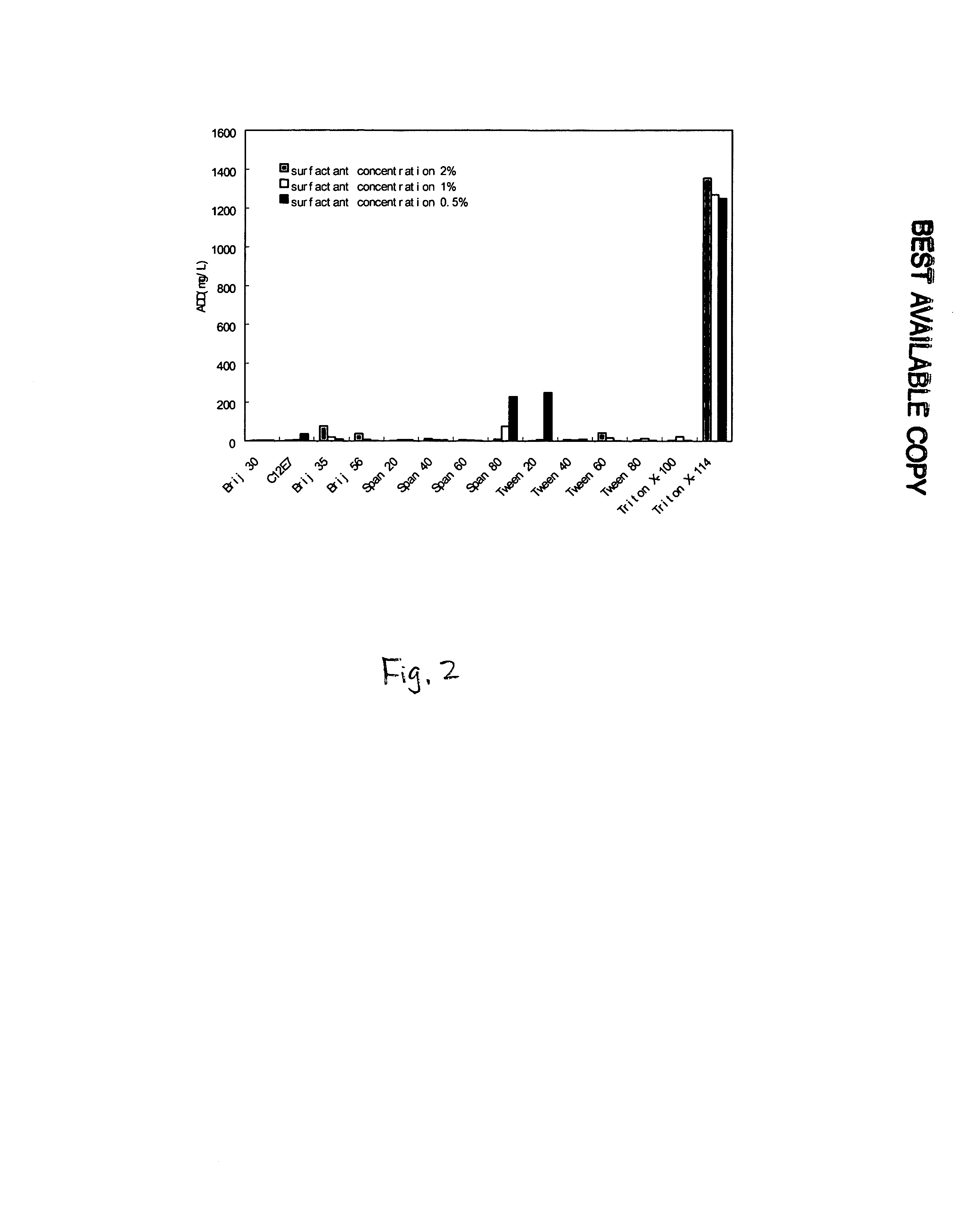Use of Cloud Point System in Biotransformation
a technology of biotransformation and cloud point system, which is applied in the field of microorganism technology, can solve the problems of the inability to biotransform hydrophobic compounds in aqueous medium, and achieve the effect of reducing the toxicity of both substrate and produ
- Summary
- Abstract
- Description
- Claims
- Application Information
AI Technical Summary
Benefits of technology
Problems solved by technology
Method used
Image
Examples
example 1
[0051] Microbial strain Mycobacterium sp. NRRL B 3683 is able to remove the side chain of cholesterol, giving out ADD and 4-AD as final products, at a ratio of ca. 10:1. Slant culture medium (100 ml): yeast extract 0.5 g, agar 1.2 g, glycerol 1.0 g, H2KPO4 0.05 g, (NH4)SO4 0.1 g, MgSO4.7H2O 0.05 g
[0052] Seed culture medium (100 ml): (NH4)SO4 0.5 g, Na2HPO4 0.45 g, KH2PO4 0.34 g, MgSO4.7H2O 0.05 g, glycerol 1.0 g, cholesterol 0.2 g, Triton X-100 0.2 g
[0053] Transformation medium (100 ml): (NH4)SO4 1.0 g, Na2HPO4 0.45 g, KH2PO4 0.34 g, MgSO4.7H2O 0.2 g, cholesterol 1.45 g, mixture of Triton X-100 and Triton X-114 (1:1) 10.0 g
[0054] Microbial Cultivation
[0055] The seed culture was grown aerobically at 28° C. at 220 r / min for 3 days with 20 ml of medium in a 250 ml Erlenmeyer flask. The seed culture was then transferred by 10% into 22 ml of transformation medium in a 250 ml Erlenmeyer flask, which was then shaken at 28° C. at 220 r / min for 7 days. A portion of the well-mixed transfo...
example 2
[0058] Microbial strain Mycobacterium sp. NRRL B 3683 is able to remove the side chain of cholesterol, giving out ADD and 4-AD as final products, at a ratio of ca. 10:1.
[0059] Slant culture medium (100 ml): yeast extract 0.5 g, agar 1.2 g, glycerol 1.0 g, H2KPO4 0.05 g, (NH4)SO4 0.1 g, MgSO4.7H2O 0.05 g
[0060] Seed culture medium (100 ml): (NH4)SO4 0.5 g, Na2HPO4 0.45 g, KH2PO4 0.34 g, MgSO4.7H2O 0.05 g, glycerol 1.0 g, mixed phytosterol 0.2 g, Triton X-100 0.2 g
[0061] Transformation medium (100 ml): (NH4)SO4 1.0 g, Na2HPO4 0.45 g, KH2PO4 0.34 g, MgSO4.7H2O 0.2 g, mixed phytosterol 2.0 g, mixture of Triton X-100 and Triton X-114 (1:1) 10.0 g
[0062] Microbial Cultivation
[0063] The seed culture was grown aerobically at 28° C. at 220 r / min for 3 days with 20 ml of medium in a 250 ml Erlenmeyer flask. The seed culture was then transferred by 10% into 22 ml of transformation medium in a 250 ml Erlenmeyer flask, which was then shaken at 28° C. at 220 r / min for 7 days. A portion of the ...
example 3
[0066] Microbial strain Mycobacterium sp. NRRL B 3683 is able to remove the side chain of cholesterol, giving out ADD and 4-AD as final products, at a ratio of ca. 10:1.
[0067] Media
[0068] Slant culture medium (100 ml): yeast extract 0.5 g, agar 1.2 g, glycerol 1.0 g, H2KPO4 0.05 g, (NH4)SO4 0.1 g, MgSO4.7H2O 0.05 g
[0069] Seed culture medium (100 ml): (NH4)SO4 0.5 g, Na2HPO4 0.45 g, KH2PO4 0.34 g, MgSO4.7H2O 0.05 g, glycerol 1.0 g, cholesterol 0.2 g, Triton X-100 0.2 g
[0070] Transformation medium (100 ml): (NH4)SO4 1.0 g, Na2HPO4 0.45 g, KH2PO4 0.34 g, MgSO4.7H2O 0.2 g, cholesterol 2.0 g, mixture of Triton X-100 and Triton X-114 (1:1) 10.0 g
[0071] Microbial Cultivation
[0072] The seed culture was grown aerobically at 28° C. at 220 r / min for 3 days with 20 ml of medium in a 250 ml Erlenmeyer flask. The seed culture was then transferred by 10% into 22 ml of transformation medium in a 250 ml Erlenmeyer flask, which was then shaken at 28° C. at 220 r / min for 7 days. A portion of the...
PUM
| Property | Measurement | Unit |
|---|---|---|
| wavelength | aaaaa | aaaaa |
| flow rate | aaaaa | aaaaa |
| pore-size | aaaaa | aaaaa |
Abstract
Description
Claims
Application Information
 Login to View More
Login to View More - R&D
- Intellectual Property
- Life Sciences
- Materials
- Tech Scout
- Unparalleled Data Quality
- Higher Quality Content
- 60% Fewer Hallucinations
Browse by: Latest US Patents, China's latest patents, Technical Efficacy Thesaurus, Application Domain, Technology Topic, Popular Technical Reports.
© 2025 PatSnap. All rights reserved.Legal|Privacy policy|Modern Slavery Act Transparency Statement|Sitemap|About US| Contact US: help@patsnap.com



